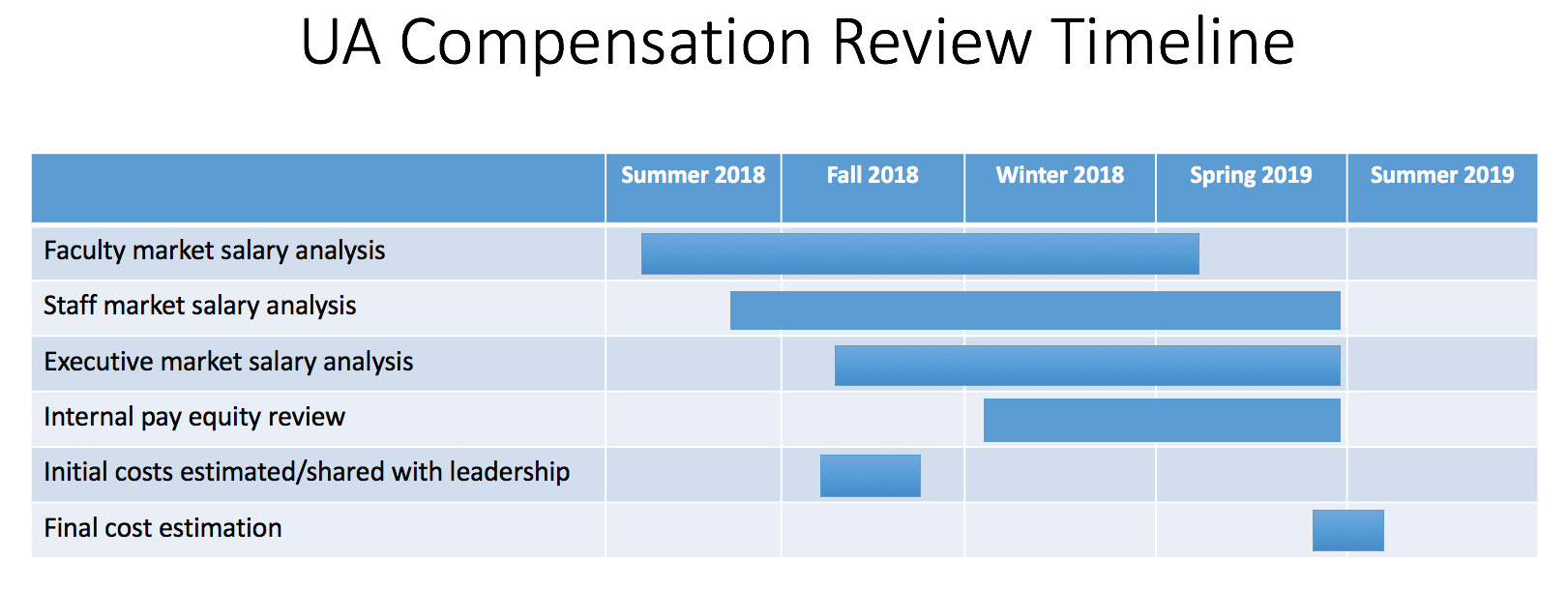Total Compensation Review
Supporting our recruitment and retention goals by maintaining market competitiveness with peer institutions and labor markets.
Elements of the Review
- Faculty salaries
- Staff salaries
- Executive (officers and senior administrators) salaries
- Benefits
- Internal pay equity
All UA employees have received a letter that provides their market salary comparison
and findings of the benefits review. See the results of the study, or the executive summary.
Review the PowerPoint and FAQs below, or visit the individual project pages for more
information:
Additional Resources for Supervisors:
- Total Compensation Review Webinar for Supervisors - DOWNLOAD SLIDES AS PDF
Compensation Study General FAQs
Archived FAQs
October 2019
If you are in the same position, a compensation increase equal to 1/3 of the amount required to increase to 90% of the market median will go into effect on October 28, 2019, and be reflected in your November 22 paycheck. By December 20, 2019, you will also receive a lump sum for retroactive payment back to July 1, 2019.
If you are in a different position since July 2, your position will be evaluated on a case-by-case basis. Your current salary will be evaluated to determine if it is at least 90% of the market median. If not, the salary adjustment will be the total amount to reach 90% of the median divided by three, reflecting the three-year implementation. By December 20, 2019, you will receive a lump sum (amount salary increased to 90% of the market divided by three) for retroactive payment of your current position since the date the position was held in FY20.
No, but your current position is being evaluated and market adjustments will be applied as appropriate. If you are below 90% of the market median in your current position, you will receive a notification with more information.
The data for this initial market study is accurate to the best of our knowledge. If you believe your study result to be in error, talk to your supervisor. Validated concerns will be addressed in the next year’s study, but will not result in a market adjustment this fiscal year.
June 2019
January 2019
Before 2019
All five of the projects within this portfolio are to assess current state and placement within the market, in order to provide a framework in which UA can determine compensation methodology going forward.
Advisory committee members are expected to disseminate project status information to their constituents, as well as provide feedback on the findings as the project reports are drafted/completed.
For staff and executives, position descriptions for each classification are reviewed against industry appropriate compensation surveys. They are considered a good match if the descriptors align to at least 70 percent of the market median. For those positions that do not have a market match, they are assessed individually and compared to internal positions with similar duties and responsibility.
For faculty, industry Classification of Instructional Programs (CIP) for each discipline are compared to national faculty compensation surveys.
Each review utilizes system-wide peers, as well as each university’s individual peers.
The objective in developing each peer group was to ensure that, on the whole, each peer group included a representative cohort of comparable public (and/or private for lower division) institutions based on:
- Carnegie Classification
- Operating Budget
- Student Enrollment
- Faculty FTE
"Cost of living” refers to the costs to a consumer in a specific geographic area. It reflects the price of food, housing, groceries, transportation, education, taxes and entertainment. A true cost of living indicator would accurately measure changes over time in the total amount of money required in order to maintain a specified standard of living. Cost of living is dictated by the local demand for and supply of goods and services.
“Cost of labor” refers to the difference in pay or labor market for a job from one location to another. The cost of labor is what a particular geographic market offers as the “going rate” or compensation for its jobs and reflects the local demand for and supply of labor.

